Extending the shelf life of food and drink – far from an impossible dream
- Like
- Digg
- Del
- Tumblr
- VKontakte
- Buffer
- Love This
- Odnoklassniki
- Meneame
- Blogger
- Amazon
- Yahoo Mail
- Gmail
- AOL
- Newsvine
- HackerNews
- Evernote
- MySpace
- Mail.ru
- Viadeo
- Line
- Comments
- Yummly
- SMS
- Viber
- Telegram
- Subscribe
- Skype
- Facebook Messenger
- Kakao
- LiveJournal
- Yammer
- Edgar
- Fintel
- Mix
- Instapaper
- Copy Link
Posted: 7 November 2019 | Navneeta Kaul, Paula Hock | 5 comments
As consumers become more health-conscious and the demand for ‘clean-label’ ingredients continues to rise, the food industry is racing to come up with novel technologies to make food safe from spoilage for longer time frames without compromising the quality or flavour of that food. Navneeta Kaul and Paula Hock look at recent developments.
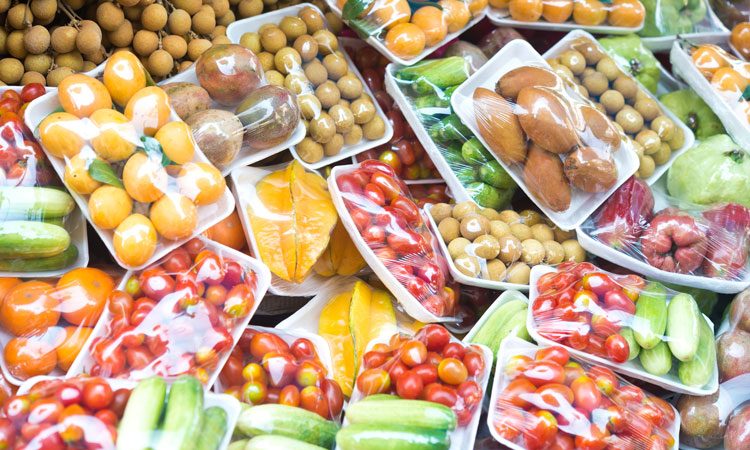

The shelf life of food and drink is determined by numerous physical and chemical factors. For years, both consumers and manufacturers have been interested in finding ways to extend it. The most recent and innovative technologies under development within this field fall within three main sections:
- Novel packaging solutions
- Next-generation additives
- Food-treatment methods
In each section, we discuss the main features of the different techniques covered, as well as the main benefits and challenges associated with each shelf life extension solution.
1. Novel packaging solutions
Companies and researchers are actively seeking out novel packaging solutions to slow food spoilage. These methods include the incorporation of plant-based or food-based materials in packaging films, protective coatings and the use of antioxidant nanoparticles, among others covered in a recent report by PreScouter1. Fig 1 shows a summary infographic of the nine packaging technologies detailed in the report that utilise plant-based and novel derivatives to extend the shelf-life of food and beverages.
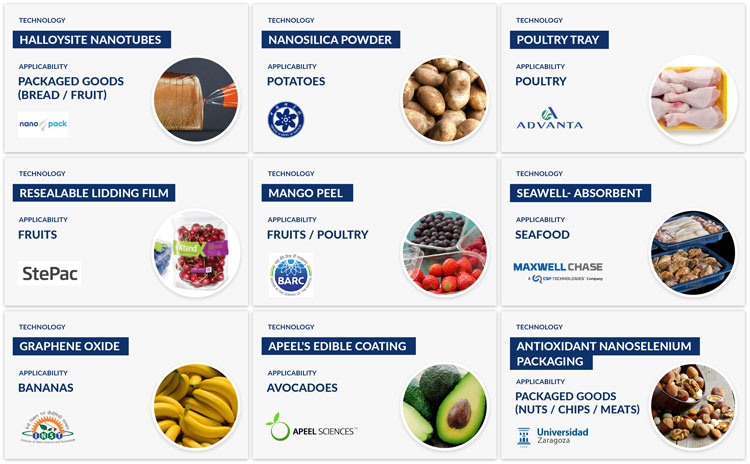

Figure 1: Shelf-life-extending packaging technologies utilising plant-based and novel derivatives
Plant-based antimicrobial packaging and coating solutions
Researchers at Nanopack2, an EU-funded three-year project, have utilised the antimicrobial property of plant-based essential oils to develop an antimicrobial packaging. The packaging involves using halloysite nanotubes (HNTs)3, hollow clay mineral fibres made up of aluminum and silicon atoms, capable of being infused with essential oils. While HNT absorbs ethylene, the ripening hormone, the infused essential oils4 act as antimicrobial agents to prevent the food from degradation. The researchers are currently testing the technical, industrial, and commercial viability of these smart antimicrobial surfaces for the application as an active food packaging solution. In a similar approach, scientists from the Bhabha Atomic Research Center (BARC) have utilised the antimicrobial and antioxidant activity of mango peels5 for incorporation into bio-based packaging films. Both these packaging solutions are safe, durable, thermally-stable and even prevent water damage to food products. However, currently, they are expensive to use, and before widespread adoption, research on more food items would be required.
Novel additive-based packaging solutions
Sprouted potatoes have elevated levels α-solanine, which is toxic to consume6. Scientists at the Chinese Academy of Sciences have devised a method to prevent sprouting in potatoes by using modified nanosilica7 with amino silicone oil (ASO) to develop a hydrophobic nanosilica powder. Coating potatoes with nanosilica has been demonstrated by the researchers to be non-penetrating and safe for human consumption. It is also a cost-effective solution. However, the biggest bottleneck with this solution is that consumers may be hesitant to use nanosilica-treated potatoes, even though it is safe.
How about an on-demand packaging solution? Scientists at the Institute of Nano Science and Technology, India, are developing an inert graphene-oxide8 based wrapper that releases salicylaldehyde (SA), on-demand. The release slows the ripening process of bananas (the target fruit of the study) and protects from spoilage-causing microorganisms. The delivery of the preservative is triggered by the acids released by ripening fruits (hence the term on-demand) and possesses minimum toxicity and more flexibility and tensile strength, compared to normal-cellulose based wrappers. This technology meets three important criteria: antimicrobial, controls ripening and is not in direct contact with fruit. However, the wrapper may have limitations in the later stages of ripening, when the acid content reduces and the late polymerisation forms a lignin, as noted by the researchers. They plan to address this challenge in their next step of research.
Novel packaging solutions
In another approach, some companies are using novel packaging solutions that eliminate the need for preservatives. Companies like Advanta9 are using alternatives to the standard modified atmosphere packaging (MAP) by using a unique combination of a skin-pack aluminum poultry tray and a film which gets rid of oxygen, and contaminants that could spoil the food, allowing an increased shelf-life of up to 300 percent. Similarly, StePac10 in collaboration with Tadbik has generated a resealable lidding film, a next-generation MAP container, that successfully preserved the freshness and flavor of cherries for more than 35 days. Researchers at the University of Zaragoza are developing a flexible, multilayer packaging with selenium nanoparticles (nanoSe)11 as an antioxidant agent. The packaging could help in absorbing antioxidants such as oxygen or free radicals to prevent food spoilage and demonstrated promising results with extending the shelf-life of nuts, potato chips, cooked ham, chicken and ready-to-eat-vegetable mixtures.
These packaging solutions have generated a lot of interest as Advanta’s trays and StePac’s lidding films are robust, thermally-stable, eco-friendly, automation-friendly, and preserve the quality of the food. And, packaging with nanoSe ensures superior antioxidant properties. Despite many advantages, they have limitations. First, Advanta’s trays do not insure against spoilage-causing microorganisms. Resealable lids need further optimisation and packaging with nanoSe in the multilayer does not increase the barrier properties for secondary oxidation products such as aldehydes and hexanal.
2. Next-generation additives
Several ongoing research efforts are focused on modifying food and beverages for shelf-life extension by the addition of novel additives to the food itself. In their second report of their ‘extending shelf life’ series, PreScouter covered five next-generation additives12, summarised in Fig. 2.
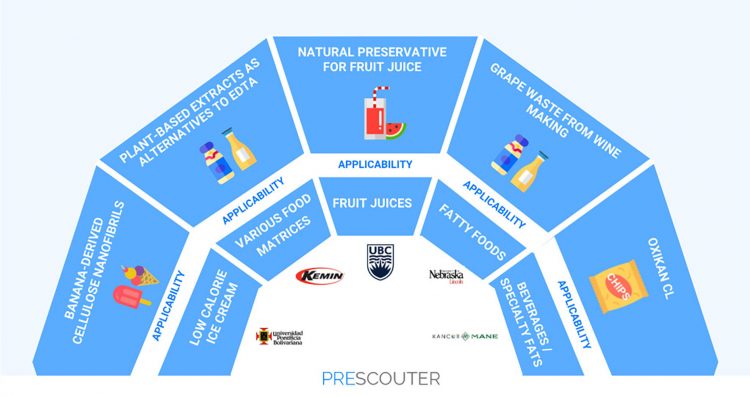

Figure 2: Next-generation additives
The additives detailed are safe and derived from plants, without additional development costs for the packaging processes. Because the additives are just an added component in the food, it results in the reduction of waste, making them environment-friendly, which is an added benefit. The additives range from essential oils to herbs or components from plant waste that could be used alone or in combination with other natural substances for improved efficacy. With further development, these plant-based additives could potentially replace synthetic additives including EDTA.
For example, Kemin13 has successfully utilised extracts from rosemary, spearmint, and green tea for prolonging the shelf life of salad dressings and sauces past six months. The blend retains its chelating abilities like EDTA and is not affected by changes in pH. Another major player in the food industry, Kancor14, has developed a natural antioxidant solution from rosemary for the shelf life extension of fat-rich foods by fighting lipid rancidity. Studies demonstrated that the solution outperformed tocopherol (another natural antioxidant), and TBHQ (a synthetic antioxidant) in food matrices.
Interestingly, some of these replacements make use of plant waste, which could further save the development cost for the production processes. Researchers at the Pontifical Bolivarian University have identified that cellulose nanofibrils15 (CNF) derived from banana waste could make ice-creams less sensitive to changes in temperature and slow melting. The CNF-enriched ice creams are lower in calorie count and have improved texture and creaminess. Similarly, from grape waste,16 scientists at the University of Nebraska-Lincoln have identified a way to extract the nutrients known as pomace to enhance the shelf life of fatty foods. Recycling plant waste for extending shelf life offers an added benefit of reducing environmental wastage and bears economic profits. However, the current process of extracting, identifying and processing CNF and grape waste is labor intensive and further tests are underway to optimise the technology before widespread commercial applications.
3. Food treatment solutions
In addition to the above mentioned methods, many research groups have focused on devising new ways to prolong the shelf life of foods and beverages away from packaging and additive solutions. This was the topic of the third and final report17 in PreScouter’s extending shelf life series. Some of the main trends covered are summarised in Fig. 3.
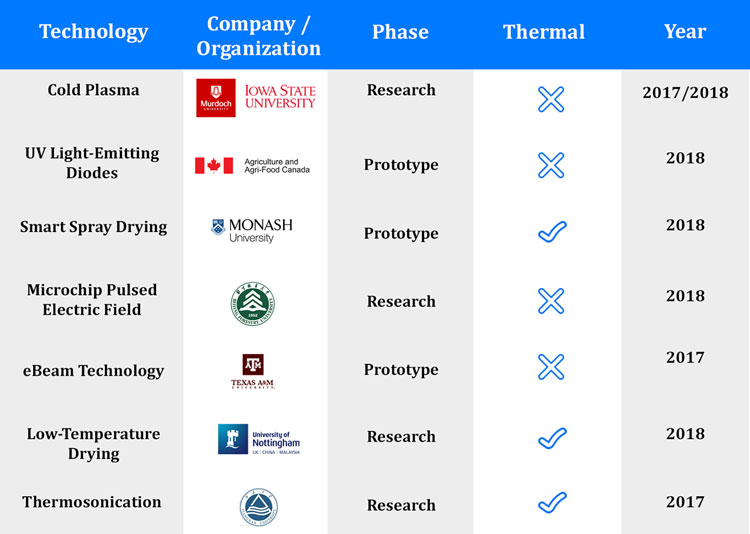

igure 3: New ways to prolong the shelf life of foods and beverages away from packaging and additive solutions
These above methods of food treatment do not require chemicals or additives to disinfect food and are effective at inactivating insects, spoilage-causing microbes and fungal spores for food preservation. Moreover, these methods do not generate waste, unlike packaging solutions. However, the commercialisation of most has been slow, and efforts are on for rapid industrial implementation.
Researchers at Murdoch University and Iowa State University have utilised cold plasma18(CP), which is a mixture of atoms, ions and excited molecules at any temperature between 25-450oC, to prevent fungal growth and preserve food quality. Though nascent in research, the technology offers a cost-effective solution, leaving no residue on the food. The biggest drawback, though, is it can damage delicate foods. At Texas A and M University, researchers have devised a type of ionising radiation, called eBeam19, to irradiate fruits and vegetables and kill associated microbes. The technology aims to eliminate the application of toxic methyl-bromide as an antimicrobial agent for food products, with no effect on the quality of the food product.
In contrast to radiation, Monash University scientists are investigating the use of spray drying20, a technique used to rapidly heat a liquid or slurry with hot gas to turn it into powder, for extending the shelf life of milk and dairy products. However, the technique is still in its nascent stage of research and requires optimisation to control temperature and pressure to prevent runaway reactions. In another exciting physical treatment, researchers are also investigating the use of microchip pulsed electric field21 as an alternative to high-temperature short time (HTST) treatments for the sterilisation of fruit juices. This non-thermal food preservation technology destroys the microbial cell walls by high-voltage electric pulses – electrocuting the bad bugs! Again, the technology is in the early research phase and requires more testing before industrial application.
Final thoughts
Consumers are continually pushing for longer shelf lives and better food quality for the things they buy. “Food preservation is no longer a concern just for industry-related clients, but for consumers as well,” comments Dr. Paula Hock, PreScouter Project Architect who oversaw the reports. “The research in this area is especially interesting, as it’s an industry that really listens to the consumer base,” adds Hock. The novel approaches discussed in this article provide the food and beverage industry with actionable insights and applicable knowledge. The industry is actively listening to its consumer base, and efforts are ongoing to satisfy the needs of the savvy and well-aware consumer. The time is ripe for innovations in the food industry to meet the challenge and deliver.
About the authors
Navneeta Kaul


Navneeta is a member of PreScouter’s global scholar network and is working as a Scientist I at KBI Biopharma in Boulder, Colorado. She holds a Ph.D. in biology from the University of Denver and also has a biotech engineering background. The focus of her research was to understand the mechanism of memory formation and how defects in it can cause the autism disorder known as Fragile X syndrome. She is passionate about communicating new technologies, research and business advances to a broader audience.
Paula Hock


Paula Hock is one of PreScouter’s Project Architects. She heads the Transportation segment, which encompasses Automotive and Aerospace and Defense projects. Paula works with research teams to provide clients with cutting-edge, actionable information to improve their businesses. This can mean problem solving, process optimisation, entering new markets, assessing intellectual property, and more. Paula earned her B.S. from DePaul University in Chicago before continuing on to her Ph.D. in Physical Chemistry at the University of Pittsburgh. She continues to utilise her chemistry background and penchant for researching new areas in a variety of engagements with PreScouter’s clients.
References
- https://www.prescouter.com/inquiry/extending-shelf-life-novel-packaging/
- https://www.nanopack.eu/
- http://ec.europa.eu/research/infocentre/article_en.cfm?&artid=49196&caller=other
- http://ec.europa.eu/research/infocentre/article_en.cfm?&artid=49196&caller=other
- https://onlinelibrary.wiley.com/doi/full/10.1111/jfs.12385
- https://www.nature.com/articles/cddis2015219
- https://pubs.acs.org/doi/abs/10.1021/acssuschemeng.8b01860
- https://pubs.acs.org/doi/10.1021/acsami.8b02048
- https://www.foodprocessing-technology.com/news/advanta-launches-new-packaging-solution-poultry/
- stePac
- https://www.ncbi.nlm.nih.gov/pmc/articles/PMC6215303/
- https://www.prescouter.com/inquiry/extending-shelf-life-next-generation-additives/
- https://www.kemin.com/na/en-us/home
- https://www.kemin.com/na/en-us/home
- https://newatlas.com/banana-waste-ice-cream/53901/
- https://xtalks.com/grape-waste-from-wine-making-process-found-to-be-a-natural-preservative-1250/
- https://www.prescouter.com/inquiry/extending-shelf-life-food-treatment-methods/
- https://onlinelibrary.wiley.com/doi/abs/10.1111/ppa.12825
- www.foodsafetymagazine.com/magazine-archive1/aprilmay-2018/electron-beam-technology-a-platform-for-safe-fresh-and-chemical-free-food/
- https://phys.org/news/2018-07-technology-shelf-life-dairy-exports.html
- https://www.sciencedirect.com/science/article/pii/S030881461831505X?via%3Dihub21
Issue
Related topics
Clean Label, Food Safety, Ingredients, New product development (NPD), Packaging & Labelling, Shelf life




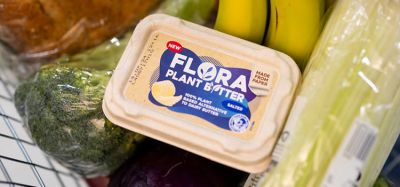


Thanks for sharing about this topic.
Thanks for sharing about this amazing packaging solution. Lovely one
Thanks for sharing this packaging concept with us.
Thanks for sharing about this packaging solution, love to know about something new.
Its actually amazing packaging solutions concept. Thanks for sharing this content